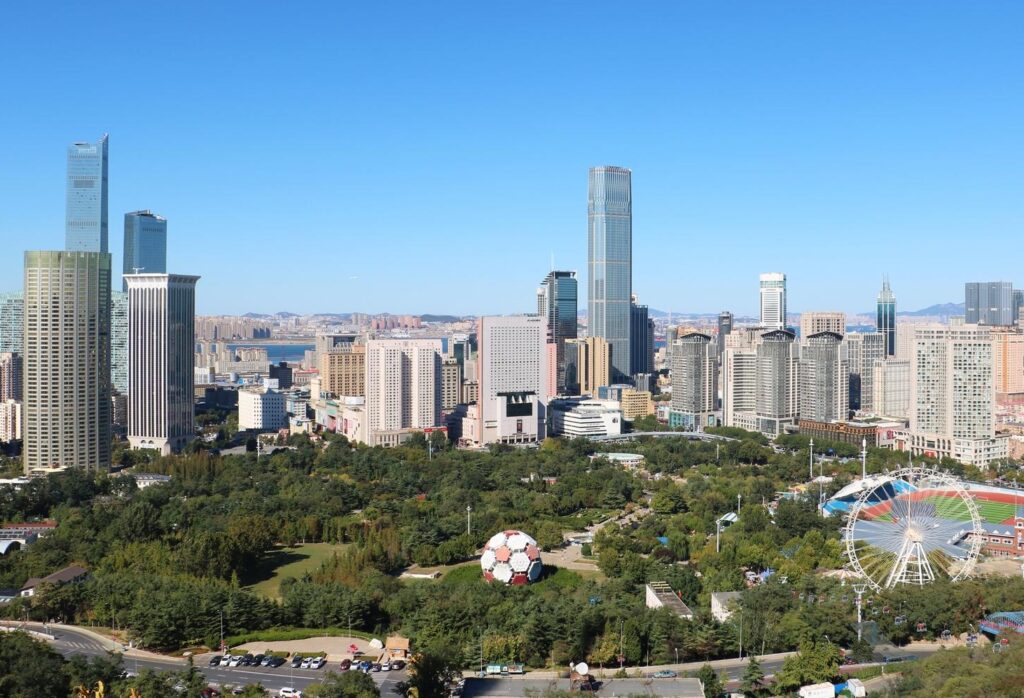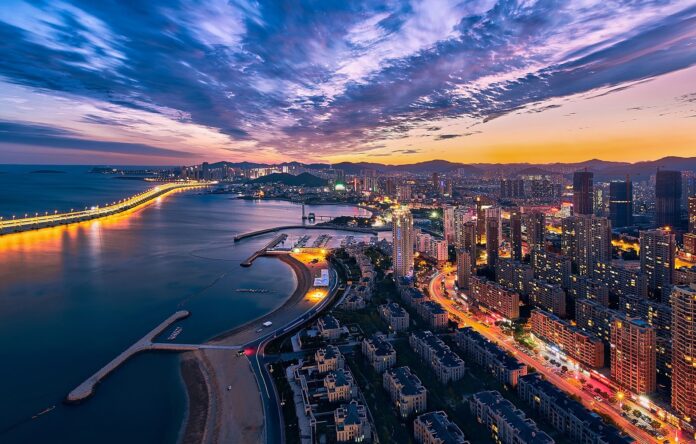Dalian, a sub-provincial city in Liaoning Province and a city specifically designated in the plan, is known as “Northern Hong Kong”. In the early 1990s, Dalian was the first mainland city to propose to build on Hong Kong as a model. At that time, Dalian’s industry and commerce were developed, and the total economic volume ranked among the top ten in the country. It was a rising pearl in the north.
Unfortunately, not only did Dalian fail to embrace the free economy and create greater glories, but instead took the lead on the road of decline and lost a full 20 years.
Today’s Dalian “Northern Hong Kong” is no longer in its glory, its economic status continues to decline, and its total GDP ranks out of the 20th in the country. Go to VisaExpress for more China business travel information.
-
Once China’s second largest trading port

In history, Dalian was still a small fishing village in a corner. Due to its superior geographical location and the condition of an ice-free port, the Qing government opened Dalian as a military seaport in 1881, opening the history of Dalian’s urban development.
In 1905, after Japan took over Dalian from Tsarist Russia, it built the Port of Dalian and the Nanman Railway connecting the northeastern mainland, making Dalian the only hub city in the Northeast that realizes sea-rail combined transportation.
Throughout the period of Japanese occupation, Dalian’s foreign trade was extremely prosperous due to the implementation of the free port system. Food, cotton, oil and other resource products from the Northeast are transported to Japan through the Port of Dalian, while industrial products from Japan are also transported to various parts of the Northeast through the Dalian Port-Nanman Railway.
In the 1930s, Dalian had become the busiest entrepot trade port in the north. Whether in terms of industrial scale or port throughput, it was the second largest trade port in China after Shanghai.
During the First Five-Year Period, Dalian’s powerful heavy industry was an important force for the Republic to promote industrialization at that time.
-
After the reform and opening up, the leading northern pearl

By the 1970s, Dalian had formed a complete industrial system, and the output value of heavy and chemical industries such as shipbuilding, machinery, chemicals, and iron and steel was among the best in the country. After the reform and opening up, Dalian became the first batch of coastal open cities, enjoying a flexible opening policy.
In 1984, the “Shenzhou First Development Zone”—Dalian Economic and Technological Development Zone was established. In 1985, Dalian became a separate city with provincial-level economic management authority and the power to engage in import and export trade.
My country’s first national-level economic and technological development zone-Dalian Economic and Technological Development Zone
Dalian, with its open policy dividends, a solid industrial foundation, and a history of Japanese colonization, soon became a highland for the north to open to the outside world.
In 1993, Toshiba Japan’s first wholly-owned enterprise in China was established in Dalian. Since then, Japanese businessmen have come in droves, and Dalian has become the largest gathering place for Japanese-funded enterprises to invest in China in one fell swoop.
During the ten years from 1980 to 1990, Dalian’s GDP ranked among the top ten in the country, and the output value of the secondary industry was second only to Shanghai and Tianjin, ranking third in the country.
In the context of rapid economic growth, in 1992, Dalian proposed the idea of building “Northern Hong Kong”, focusing on the development of finance, tourism, and service industries to achieve urban upgrading.
Under the guidance of this policy, the heavy and chemical industries became an obstacle to transformation overnight, and were cleared out of the urban area one by one, resulting in a blow to the industrial system that Dalian had accumulated for many years.
At the same time, for the sake of its image as an international city, Dalian has focused its work on the transformation of the city, and began to be keen on building skyscrapers and grand infrastructure. Buildings such as the largest city square in Asia abound.
As a result, Dalian’s urban construction has led other cities in China for twenty years. However, it is impossible to build “Northern Hong Kong” only with the ever-changing city appearance. The seemingly beautiful 90s was also a turning point for Dalian from its prosperity to decline.
-
The lost 20 years

Since 2000, Dalian’s economy began to slow down. In this year, Dalian was surpassed by Qingdao and lost the third city in the north.
In 2003, in the context of the revitalization of the Northeast, Dalian proposed the “Greater Dalian” strategy, which set off a second wave of major infrastructure construction, and relocated some universities and enterprises to Lushun and Puwan in an effort to expand the city’s territory and reshape it with scale advantages. Dalian Development.
In terms of industry, Dalian has returned to the development path of heavy industry, supporting petrochemical, shipbuilding and modern equipment industries that were “disliked” in the past. The whole city is under the development mentality of spreading a big pie, which has caused a heavy financial expenditure burden, which caused Dalian to miss the opportunity to adjust the industrial structure, and was finally left behind by the times, and lost the 20-year development opportunity period.
What’s the reason for the decline of Dalian? The first decade of reform and opening up is the honeymoon period between China and Japan. At this time, Dalian’s near-water buildings have a great first-mover advantage. Former Japanese Prime Minister Yasuhiro Nakasone once said: Dalian is a rare and ideal investment place, and it has an immeasurable value. Development prospects.
In the face of the tide of the times, Dalian seized the first round of opportunities for foreign trade development and undertook the industrial transfer from Japan. However, Dalian, which has tasted the benefits, has not adjusted its foreign trade structure in a timely manner and increased the training of independent enterprises. It is still highly dependent on the development of Japanese capital.
Since 2003, as Sino-Japanese relations entered a period of freezing, Dalian’s foreign trade environment began to deteriorate and the economy became very fragile.

Second, the strategy is fluctuating. In the early 1990s, Dalian’s “Northern Hong Kong” vision was undoubtedly advanced at the time. However, it did not happen at the right time. At that time, the domestic financial, high-tech, and Internet industries had not yet formed a climate, and industrialization and urbanization had just begun. Dalian It is obviously impossible to directly transition to an economic system dominated by service industries before Beijing and Shanghai.
Under the setbacks, Dalian returned to its heavy industry development route in 2003. At this time, the domestic processing and manufacturing industry was in full swing, and the Internet and high-tech industries began to rise. The mistake of Dalian’s strategic choice made it miss the modern service industry economy.
In 2010, once again frustrated Dalian proposed a new strategy of “three centers, one cluster” (Northeast Asia International Shipping Center, Northeast Asia International Logistics Center, Regional Financial Center, and Modern Industry Cluster), and re-selected the tertiary industry as the new strategy. The main industrial structure.
However, the competitiveness of Dalian at this time is not as good as in the past, and it is difficult to break through.
Third, the reform is not thorough. For a long period of time, Dalian was a city dominated by the state-owned economy, and state-owned enterprises once accounted for more than 60% of the national economy.
In the first 10 years of the reform, under the influence of vigorously attracting foreign capital, Dalian has formed a three-part world of state-owned enterprises, private enterprises and foreign capital.
However, Dalian has not followed the path of reform. Under the guidance of the “heavy industry” development strategy, state-owned enterprises have re-emerged, going against the tide of development of the times, and have gradually become a city dominated by the private economy in the south. Leave it far.
With the overall economic recession in the Northeast, Dalian has ushered in an era where investment in Shanhaiguan is not enough and the population is exodus. Nowadays, Dalian’s position in the north is declining. Its GDP has not only been surpassed by Qingdao, Zhengzhou, and Yantai, but even the status of the “Northeast Brother” has been shaky.
Where will Dalian in the future go?









